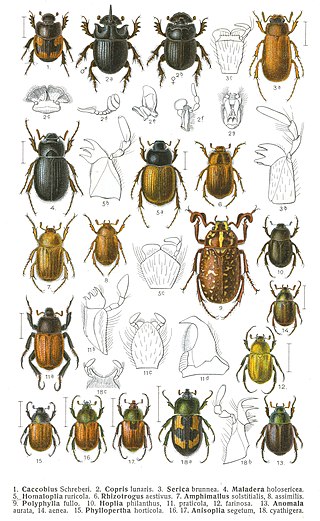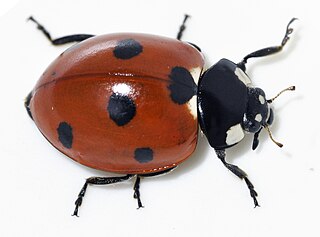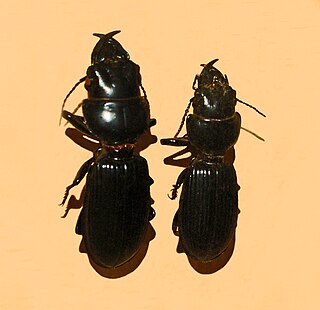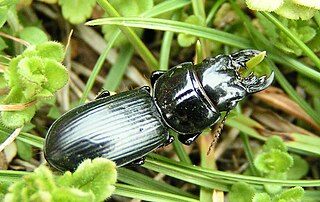
Beetles are insects that form the order Coleoptera, in the superorder Endopterygota. Their front pair of wings are hardened into wing-cases, elytra, distinguishing them from most other insects. The Coleoptera, with about 400,000 described species, is the largest of all orders, constituting almost 40% of described insects and 25% of all known animal species; new species are discovered frequently, with estimates suggesting that there are between 0.9 and 2.1 million total species. Found in almost every habitat except the sea and the polar regions, they interact with their ecosystems in several ways: beetles often feed on plants and fungi, break down animal and plant debris, and eat other invertebrates. Some species are serious agricultural pests, such as the Colorado potato beetle, while others such as Coccinellidae eat aphids, scale insects, thrips, and other plant-sucking insects that damage crops.

The family Scarabaeidae, as currently defined, consists of over 30,000 species of beetles worldwide; they are often called scarabs or scarab beetles. The classification of this family has undergone significant change in recent years. Several subfamilies have been elevated to family rank, and some reduced to lower ranks. The subfamilies listed in this article are in accordance with those in Bouchard (2011).

Stag beetles are a family of about 1,200 species of beetles in the family Lucanidae, currently classified in four subfamilies. Some species grow to over 12 centimetres, but most to about 5 cm (2 in).

The longhorn beetles (Cerambycidae), also known as long-horned or longicorns, are a large family of beetles, with over 35,000 species described. Most species are characterized by extremely long antennae, which are often as long as or longer than the beetle's body. In various members of the family, however, the antennae are quite short and such species can be difficult to distinguish from related beetle families such as the Chrysomelidae. The scientific name of this beetle family goes back to a figure from Greek mythology: after an argument with nymphs, the shepherd Cerambus was transformed into a large beetle with horns.

Buprestidae is a family of beetles known as jewel beetles or metallic wood-boring beetles because of their glossy iridescent colors. Larvae of this family are known as flatheaded borers. The family is among the largest of the beetles, with some 15,500 species known in 775 genera. In addition, almost 100 fossil species have been described.

Prostomidae is a family of beetles with no vernacular common name, though recent authors have coined the name jugular-horned beetles. They are often found in dead wood. The family consist of two extant genera with about 20 species. Prostomis americanus is known from North America. Other species of Prostomis are found in Europe, Africa, the Pacific region and East Asia. Species of Dryocora are known from New Zealand, Australia and Tasmania.

Deroceras reticulatum, common names the "grey field slug", "grey garden slug", and "milky slug", is a species of small air-breathing land slug, a terrestrial pulmonate gastropod mollusc in the family Agriolimacidae. This species is an important agricultural pest.

Ptinidae is a family of beetles in the superfamily Bostrichoidea. There are at least 220 genera and 2,200 described species in Ptinidae worldwide. The family includes spider beetles and deathwatch beetles.

Coccinellidae is a widespread family of small beetles. They are commonly known as ladybugs in North America and ladybirds in Great Britain. Entomologists prefer the names ladybird beetles or lady beetles to avoid confusion with true bugs. Many of the species have conspicuous aposematic colours and patterns, such as red with black spots, that warn potential predators that they are distasteful.

The Asiatic rhinoceros beetle, coconut rhinoceros beetle or coconut palm rhinoceros beetle, is a species of rhinoceros beetle of the family Scarabaeidae. O. rhinoceros attacks the developing fronds of raffia, coconut, oil, and other palms in tropical Asia and a number of Pacific islands. Damaged fronds show typical triangular cuts. The beetle kills the palms when the growing point is destroyed during feeding. They also infest dead trunk debris.

Scarites striatus is a species of beetles of the family Carabidae.

Scarites buparius is a species of beetles belonging to the family Carabidae.

Scarites quadriceps is a species of ground beetle in the family Carabidae. It is found in North America. It can be found beneath debris on the edges of fields or beaches.

Scarites vicinus is a species of ground beetle in the family Carabidae.
Scarites lissopterus is a species of ground beetle in the family Carabidae. It is found in North America.
Scarites marinus is a species of ground beetle in the family Carabidae. It is found in the Caribbean Sea, Central America, and North America.
Scarites stenops is a species of ground beetle in the family Carabidae. It is found in North America.
Cimensis is a Latin adjective meaning "from Cima", referring to either Ilhéu de Cima of Cape Verde or Ilhéu de Cima of Madeira. It may refer to several species:
Scarites guineensis is a species of ground beetle in the family Carabidae. It is found in West Africa, including Mali.
















